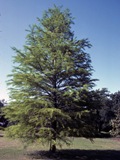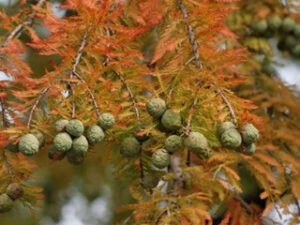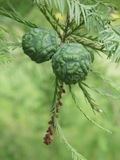
Bald Cypress, Taxodium distichum, is a deciduous conifer that grows in wet locations in Eastern North America through Mexico and Guatemala. In the Texas Hill Country, they grow prolifically along permanent creeks and rivers. Also known as the Southern Bald Cypress, Deciduous Cypress, White Cypress, Swamp Cypress, Gulf Cypress, and Tidewater Red Cypress, this stately tree grows to 50’-75’ or taller. They are slender and conical when young and develop a flat top in very old age.
 The feathery leaves of the Bald Cypress are sage green and deciduous but before they fall in autumn, they turn a glorious copper color which accounts for one of their monikers, Red Cypress. The male cones are tan, 3”-5” long and grow in drooping clusters; the female cones are spherical and grow in small groups or individually. The fruit is a wrinkled green sphere that ripens and turns brown in October-December. The red-brown bark exfoliates to silver and is thin and fairly smooth. The tapered trunk is slightly buttressed at a swollen base.
The feathery leaves of the Bald Cypress are sage green and deciduous but before they fall in autumn, they turn a glorious copper color which accounts for one of their monikers, Red Cypress. The male cones are tan, 3”-5” long and grow in drooping clusters; the female cones are spherical and grow in small groups or individually. The fruit is a wrinkled green sphere that ripens and turns brown in October-December. The red-brown bark exfoliates to silver and is thin and fairly smooth. The tapered trunk is slightly buttressed at a swollen base.
 Although they thrive best in wet areas, Bald Cypress will also grow in well-drained soil. They are planted as ornamentals in colder climates and drier soils. These are long-lived trees; some are over 1,000 years old and are among the oldest living things in North America. They were growing when dinosaurs dominated the Hill Country. Cypress heartwood resists decay and it is often used for heavy construction such as docks, boats, bridges and warehouses.
Although they thrive best in wet areas, Bald Cypress will also grow in well-drained soil. They are planted as ornamentals in colder climates and drier soils. These are long-lived trees; some are over 1,000 years old and are among the oldest living things in North America. They were growing when dinosaurs dominated the Hill Country. Cypress heartwood resists decay and it is often used for heavy construction such as docks, boats, bridges and warehouses.

Many Central Texas landscapes boast a Bald Cypress as its centerpiece. The cones provide food for wildlife and ducks that nest in cavities use old, hollow trees for their nest sites. It is the larval host to the Baldcypress sphinx moth.